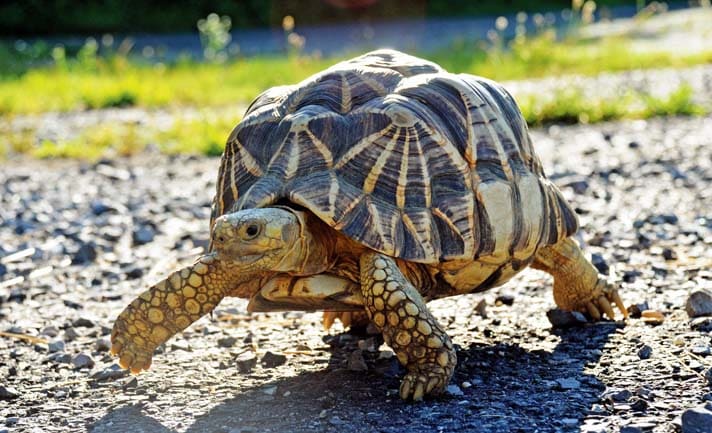Captive breeding may be the last chance of survival for the Burmese star tortoise.
The reptile community has long been utterly obsessed with species that feature alluring patterns and vibrant colors. It has also been fixated on the rare and endangered. One tortoise covers it all and has remained a sort of “holy grail” in the eyes of enthusiasts across the globe. The Burmese star tortoise (Geochelone platynota) has certainly reached stardom in terms of popularity and receiving attention from not only keepers, but from conservationists, as well.
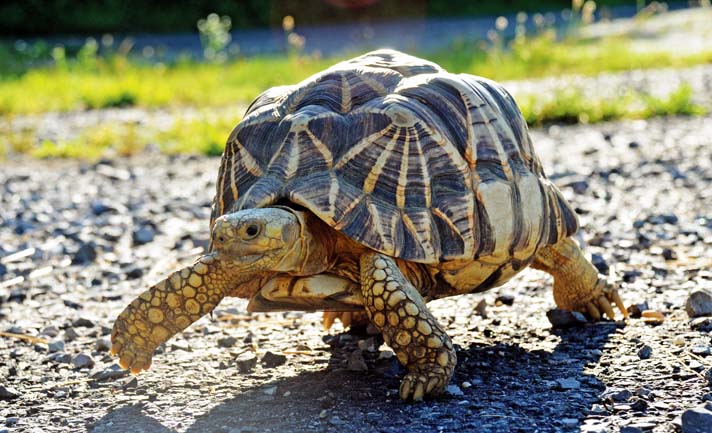
Chris Leone
Burmese star tortoise.
It is certainly an impressive animal, standing tall as it walks purposefully (as you can see in the photo to the left), but today, much of its walking is done almost exclusively in captive situations. This is because the Burmese star is in serious trouble in nature. The IUCN currently lists it as critically endangered, but the truth is that this species is actually said to be fundamentally extinct. This is because there are not enough tortoises left in the wild to do the species any good. So few are left that even dog-sniffing teams led by volunteers have only been able to turn up a handful of specimens after searching for more than two weeks.
Little is known about G. platynota in nature and, in fact, from 1982 until 1996, the IUCN had its status designated as “Insufficiently Known.” Classic reasons associated with over-collection for the pet trade and human consumption (Burmese star tortoises are eaten by both the Chinese and Burmese) have destroyed populations. Collecting of this species for the pet trade has actually never been legal, and it is reported that Myanmar has never granted export permits to allow them out of Burma. This backs up the assumption that a vast amount of captive-produced Burmese star tortoises derive from illegally caught wild adults.
Severe conservation measures have been taken in the last few years to try to reestablish Burmese star tortoises in their homeland. Various breeding and head-starting programs have been launched, but sadly, many of the released tortoises are still showing up in illegal trade markets across the world.
Burmese Meets Indian
Also referred to as the “flat-backed tortoise,” G. platynota possesses a large carapace that is flattened along the vertebral scutes, resulting in a broad, less-domed appearance than many other tortoise species. The ground color is brown to black, with some specimens exhibiting more of a caramel color.
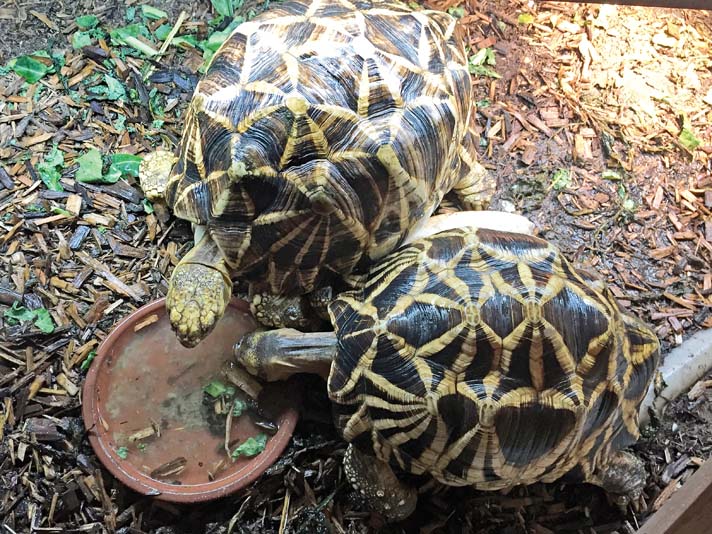
chris leone
Geochelone platynota is considered a star tortoise because the carapace design resembles that of the common Indian star tortoise (G. elegans).
A stunning display of yellow, flower-petal-like striations appear on each scute, and when viewed from above, the carapace exhibits a netted, somewhat symmetrical pattern. Geochelone platynota is considered a star tortoise because the carapace design resembles that of the common Indian star tortoise (G. elegans). The Burmese was once considered to be a subspecies of the Indian, but has since been elevated to full species rank. It can be differentiated from the Indian by comparing the markings of both the carapace and plastron.
The Burmese typically features six points to the striation on each scute (although the first vertebral scute may have only five points, and the first coastal scute on each side may number more than six). The net-like pattern on the carapace is a result of the points of each striation joining at the scute seams. In contrast, G. elegans has a higher-domed carapace with striations that have more than six points on each scute. These points or rays increase in number as a tortoise grows, eventually resembling lines more than flower petals.
On the plastron, the Burmese star tortoise displays a yellow ground color with darker triangular areas. These markings point toward one another along the mid-seam. Faint lines resembling a brushing effect of additional dark pigment may also be present. On the Indian, the star-like pattern on the carapace continues onto the plastron, but usually with wider rays forming a sunburst or pinwheel representation on each scute.
The large, predominantly yellow head and limbs of the Burmese star can also help set it apart from the Indian, which has a smaller head with yellow and black markings that continue throughout the limbs and soft parts of the body.
Both species can attain impressive sizes, but the Burmese takes the cake when it comes to size. Females are typically larger, surpassing 12 inches regularly, and even reaching more than 14 inches, but males can come close or get just as big. Size is much more variable for the Indian, with island specimens reaching 12 inches (these are commonly referred to as the Sri Lankan star tortoises, which are not a separate subspecies) and mainland ones being much smaller or nearly as large in certain geographical areas. The largest Indian star in our collection is 9½ inches fully grown, while the largest Burmese star we have is 13 inches and still growing.
Wintering the Burmese Star Tortoise Indoors
Burmese star tortoises are not particularly tough to house, but they do require space. They also do not hibernate, and even though they can tolerate a wide range of temperatures and are considered hardy, exposure to winter conditions in many parts of the U.S. would be unacceptable. Our tortoises are subjected to temperatures ranging from 100 degrees Fahrenheit down to the upper 40s briefly during parts of the year, and they are fine.
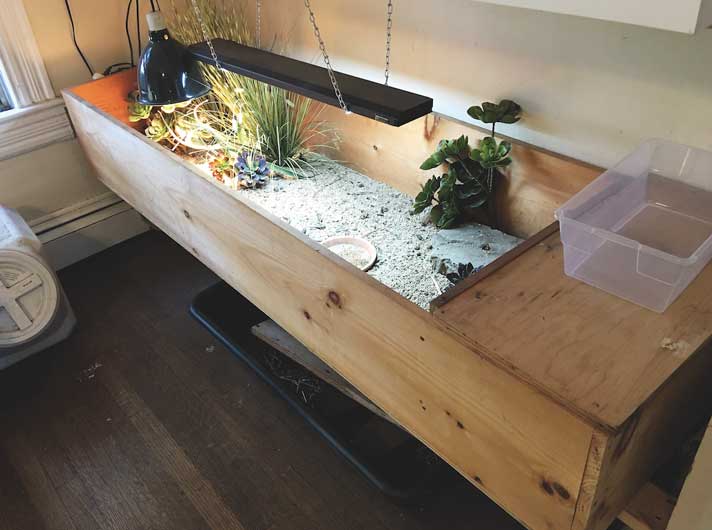
chris leone
From October until sometime in April, our Burmese stars are maintained indoors, in 8×4-foot enclosures I construct out of plywood.
From October until sometime in April, our Burmese stars are maintained indoors, in 8×4-foot enclosures I construct out of plywood. No more than two adult tortoises are kept in each. The sexes are kept separately and only introduced periodically, except when they are housed together during the summer. The main reason we don’t keep them together otherwise is because the females’ nesting season starts in October, and males will continually pester the females and are capable of interrupting the nesting process, unnecessarily stressing the females. They may even destroy eggs by attempting to mount females while eggs are being laid.
While inside, Burmese star tortoises require nothing more than cypress mulch as a substrate, with a depth of about 12 inches. It is easy to clean and safe for them. Cypress mulch also retains some moisture for when artificial rains are provided through means of misting and spraying. (In its native Myanmar, the tortoise experiences a dry season and a wet season that receives significant rainfall. Dry, deciduous forests are favored, where Burmese stars lumber about, grazing on vegetation during cooler parts of the day.)
One end of each enclosure is covered, with rubber strips stapled to the front edge of the cover. The strips hang down to create a dark area in the covered section, turning it into a bit of a humid hide for the tortoises. They can walk in and out effortlessly by pushing through the “drapes.” (Ken Siffert, a tortoise breeder in New York, suggested this tip after several years of using it to successfully keep his tortoises content within their indoor overwintering quarters.) Our Burmese stars appreciate this refuge throughout the winter season, and spend most of their time inside it, only coming out to nest, feed and bask.
Lighting and heat are provided by suspending a Zoo Med 10.0 UVB T5 fluorescent tube across each unit, and by hanging a 90- to 120-watt indoor/outdoor floodlight on the end opposite the covered section for basking. Basking sites should reach 100 to 105 degrees; the ambient room temperature can range between 75 and 80. At night, temperatures can be allowed to drop down into the low 60s without any additional heat needed.
Relative humidity is not very important during the tortoises’ indoor winter period, which coincides with the dry season in the species’ native Myanmar. Still, our tortoises are provided with 2-inch-deep, stainless-steel dishes for drinking water, to prevent any dehydration that may lead to hardened urates.
The only difference between the enclosures is the presence of a nesting box in the females’. A tub measuring roughly 3×3 feet and 12 inches deep is sunken into the substrate of the females’ units. It is filled with organic potting mix, topsoil, sand and some peat moss. Packed down and kept moist, it provides females an easily accessible area in which to deposit their eggs. Placement of the nesting box is in a corner, under the basking light, as G. platynota females seem to choose corners to back into when oviposition commences.
Outside Care of the Burmese Star Tortoise
Depending on the extended forecast, our adult Burmese star tortoises are usually placed outside by late April. By this time, the daytime temperatures are regularly hitting the low 70s, with nights dropping down to the upper 40s. Temps quickly escalate from there, with May providing much more consistent warmth.
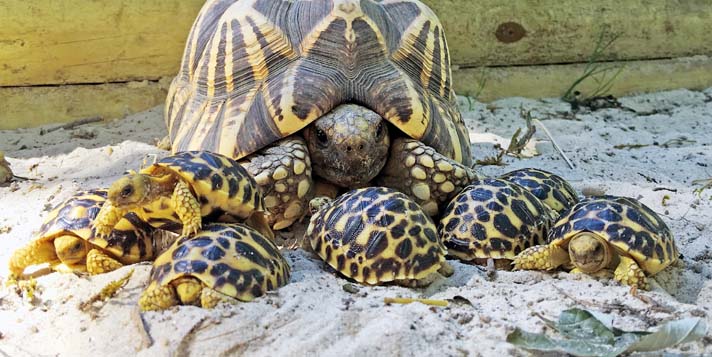
chris leone
Adult male Burmese star tortoise and offspring.
A large, well-planted outdoor enclosure measuring at least 12×20 feet can house a small group of adult tortoises, such as two males and three or four females. I prefer to use landscape timbers to construct the walls (as I do for just about all species housed at Garden State Tortoise). They are pressure treated, sturdy, attractive and inexpensive.
Because Burmese stars are large tortoises that are quite capable of climbing, their pen walls should be 18 to 24 inches tall, and all corners should be capped or otherwise constructed to prevent the tortoises from using them to climb out.
One end of our pen is equipped with an 8- by 2-foot cedar greenhouse. Built on timbers cut to size, an entrance is cut out so the tortoises can access it with ease. Polycarbonate panels on hinges allow sunlight penetration and extreme warmth even on chilly days. All it takes is a sunny day, and even if the air temperature may only be 60 degrees outside, it will be nearly 80 inside the greenhouse. Heat lamps can be suspended inside it, fitted with 250-watt infrared brooder lights (these come in handy on exceptionally cool days). I remove the existing soil inside the greenhouse and replace it with a base of paver stones with a bed of straw on top. The tortoises absolutely use the greenhouse, and return to it every night to sleep. They also bask inside it. On extremely hot summer days, the top panels can be propped up to allow for air exchange and to prevent overheating.
Pen placement and substrate consistency are crucial points to consider if you are to be successful in keeping Burmese star tortoises outdoors. A sunlit area of the yard on well-drained ground, not a grassy lawn, is best. At times, it may be necessary to remove the existing ground and replace it with something more natural, such as a soil, sand and pit-gravel mix. Areas that flood or stay soggy are not suitable for a pen for this tortoise species.
Read More
A Peek Inside The Turtle Conservancy
Indian Star Tortoise Care Sheet
Various plants should be added, as G. platynota does not like to feel exposed. Large fountain and maiden grasses, knockout rose, yucca, spirea, select hardy palms and hibiscus all work well at adding beauty and refuge to the outdoor enclosure. Driftwood and logs help to provide visual barriers while maintaining a natural landscape.
Rain often brings the tortoises out of hiding, and they will march about the enclosure while drinking from puddles. During spans of drought and extreme heat, which are common during N.J. summers, a sprinkler can be set up to give the animals some relief. Stainless-steel water dishes are also provided outdoors, so that the tortoises can drink whenever they feel the need to.
Although Burmese stars are quite large when fully grown, and they aren’t easy targets for predators, it’s always better to be safe than sorry. At night, ours can be barricaded into their greenhouse; the top panels lock, and the entrance can be blocked with a boulder, cinderblock or movable wooden door. We also use powerful electric fences, motion-sensor camera systems, dogs and traps every night, just to be absolutely safe.
What to Feed the Burmese Star Tortoise
Burmese star tortoises are hefty animals able to eat large amounts as they graze and browse. We have noted that they become active early in the morning, but even more so in the evening. It’s surprising how they can be almost nocturnal in a sense. They leave their hiding areas at dusk and graze for quite some time before turning in after nightfall.
For this reason, we typically offer our adults food late in the afternoon. The young are more active in the morning, so they are fed shortly after the lights are turned on in the morning. Dandelion, chicory, clover, mulberry leaves, hibiscus flowers, squash, cactus pads and pear, kale, escarole, collard greens and radicchio are offered regularly to both juveniles and adults. We also make a mix comprised of Mazuri Tortoise Diet (original formula) and Zoo Med Grassland Tortoise Diet, which is voraciously devoured by both adults young.
Calcium is provided by making sure cuttlebone is always available, especially for the adults. Females will consistently gnaw away at it, especially during egg-laying season. While hatchlings do nibble at it, we also sprinkle calcium powder on their food twice monthly.
Breeding and Rearing the Burmese Star Tortoise
Our female Burmese star tortoises usually deposit their eggs from October until February, and lay multiple clutches during this time. This species’ eggs benefit from a cooling period in order to break the diapause, so immediately after oviposition, the eggs are cleaned and set on dry vermiculite in plastic deli cups with small air holes in the lids. These are then placed in a wine cooler at roughly 65 degrees for 30 days. Humidity in the cooler is kept between 70 and 80 percent.
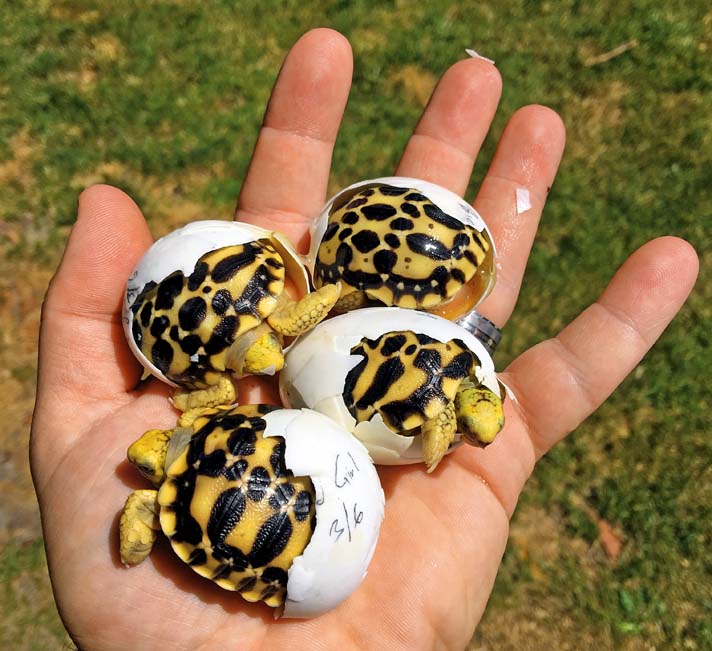
chris leone
Although G. platynota commonly fetch a high price (babies typically sell for $1,000 to $1,250 each, and mature adults can go for up to $12,000 a pair), they are exceedingly sought after as many keepers yearn to work with a fundamentally extinct species.
After 30 days, the eggs are placed into new deli cups, with holes in the lids, on moistened vermiculite (1:1 ratio by weight vermiculite to water). They are placed in incubators and maintained between 86 and 89.6 degrees, with a humidity level between 80 and 90 percent. They hatch anywhere between 88 and 122 days.
Baby G. platynota are large (23 grams on average; large compared to, for instance, a 6- to 12-gram hatchling Hermann’s tortoise) and robust upon hatching and quickly accept their first meals (they will not hesitate to eat large volumes, and they grow very fast). We keep up to five in a 2×3-foot plastic tub, on a thick layer of organic potting mix with cypress mulch mixed in. A Tupperware container, flipped upside down with an entrance cut into it, is placed at the back of the tub. This is filled with moistened sphagnum moss and the babies use it as a humid hide.
A terra cotta saucer is sunken into the substrate for a constant water supply, and babies are also soaked three to four times weekly. The hide, which hovers between 80- and 100-percent humidity, as well as a lightly misted substrate, drinking water, and soakings, help to keep the neonates consistently hydrated. This is crucial for proper development and growth.
The same Zoo Med 10.0 UVB T5 fluorescent tube used for the adults is used over the babies’ tub, and a lower-wattage floodlight is offered for basking. I use 75 watts because the neonates are housed in my warm tortoise room, where the ambient temperature can soar into the upper 80s most of the time. It’s imperative that the young tortoises do not overheat or dry out.
The Future of the Burmese Star Tortoise
Sadly, the future of the Burmese star tortoise in nature is very uncertain. It seems that despite the efforts of conservation organizations to reintroduce specimens into the wild, their small numbers are still devastated as illegal poaching reaches a cataclysmic state.
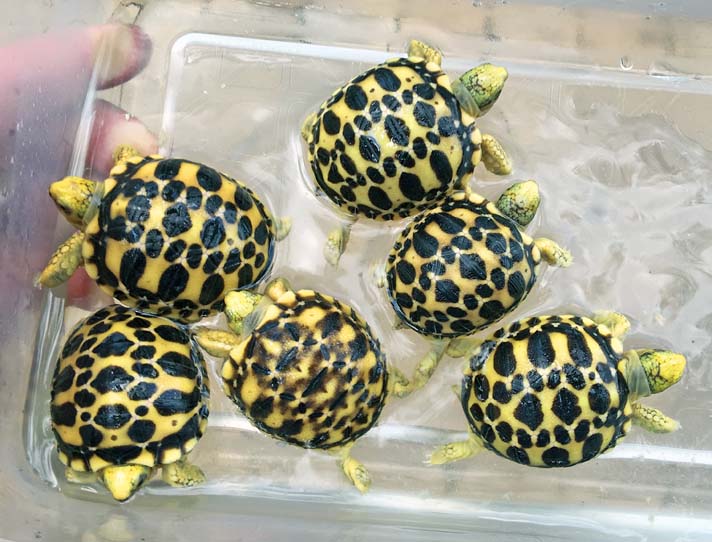
chris leone
The Burmese star tortoise can be rather prolific under the proper conditions, and is capable of laying several decent-sized clutches of eggs in just one season.
Their status in captivity, however, is on the other end of the spectrum, which does provide a glimmer of hope. Serious enthusiasts in various countries, including the U.S., are experiencing breeding success. The Burmese star tortoise can be rather prolific under the proper conditions, and is capable of laying several decent-sized clutches of eggs in just one season. It’s not unheard of for one, large, mature female to produce nearly 50 eggs.
Although G. platynota commonly fetch a high price (babies typically sell for $1,000 to $1,250 each, and mature adults can go for up to $12,000 a pair), they are exceedingly sought after as many keepers yearn to work with a fundamentally extinct species. That, along with their prepossessing looks, ability to adapt, and bright personalities, has placed them on a pedestal where they will continue to be admired by the masses. Their success story under human care shines a positive light at the end of the tragic past of the wild population. The Burmese star tortoise’s situation in nature may not be buoyant at present, but our efforts as responsible herpetoculturists can help instill confidence in knowing the species will not disappear entirely. After all, we may be its only hope.
Chris Leone is the owner of Garden State Tortoise LLC, and the director of animal husbandry for theTurtleRoom. His work with countless species of turtles and tortoises spans more than two decades. Visit him at gardenstatetortoise.com and theTurtleRoom.com.

